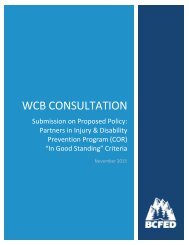KITIMAT DRAFT Report
Create successful ePaper yourself
Turn your PDF publications into a flip-book with our unique Google optimized e-Paper software.
Figure 9<br />
Linking Primary and Secondary Prevention<br />
Attribute #7 - Key Research:<br />
Fewer incidents resulting in lost work days and fewer workers’ compensation claims in organizations that<br />
were more diligent and thorough in their safety efforts, devoted management time and resources to support<br />
prevention, took a proactive approach to return to work (beginning early and involving all concerned parties in<br />
the process), and created a work climate that values people. (Habeck, Hunt & VanTol - 1998, Habeck, Scully,<br />
VanTol & Hunt – 1998)<br />
In addition, workplaces with lower LTFR (lost time frequency rate) benefitted by having JHSCs with more<br />
executive functions and greater worker involvement. In conclusion, managerial and worker participation in<br />
OHS initiatives characterizes safer workplaces. Also, general concern of management towards OHS, illustrated<br />
by both attitudes and concrete actions, is also associated with lower injury rates. (Geldart et al – 2010)<br />
Our main findings show strong evidence to support the economic merits of ergonomic and other MSK injury<br />
prevention interventions in the manufacturing and warehousing sector and strong evidence to support systemlevel<br />
disability management interventions that cut across multiple sectors. (Tompa et al – 2009)<br />
Our findings suggest that job-level factors, workplace factors and policy about minimum job tenure for<br />
mandatory work accommodation are stronger determinants of offer and acceptance of work accommodation<br />
than individual health factors, 1 month post-injury. (Franche et al – 2009)<br />
Additionally, worker and management collaboration through JHSCs continues to play an important role in<br />
generating and maintaining safe and healthy workplaces. Internal responsibility for occupational health and<br />
safety comes not only from management but also from the interaction between management and labour,<br />
from mandated safety committees and from empowered workers. As expected, greater agency of the JHSC<br />
was related to lower injury rates. While nearly all JHSCs were responsible for conducting inspections and<br />
investigating serious accidents, JHSCs at firms with lower injury rates were more likely to have executive<br />
functions and to be responsible for the training of workers. They were also more likely to work in collaboration<br />
with management. (Geldart et al – 2010)<br />
<strong>DRAFT</strong><br />
In conclusion, we have shown in this project that disability can be prevented and successfully managed to<br />
the benefit of the company and its employees when it is a conscious and coordinated part of the company’s<br />
overall goals. The twin strategies of trying to prevent injuries in the first place and working to minimize<br />
their disabling effects through disability management techniques in the second place, are both shown to be<br />
productive in reducing workplace disability. (Hunt et al – 1993)<br />
Situational assessment<br />
District of Kitimat<br />
39





